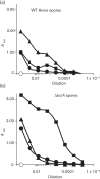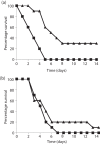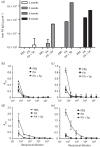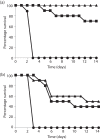Characterization of a multi-component anthrax vaccine designed to target the initial stages of infection as well as toxaemia
- PMID: 22767539
- PMCID: PMC3541767
- DOI: 10.1099/jmm.0.045393-0
Characterization of a multi-component anthrax vaccine designed to target the initial stages of infection as well as toxaemia
Abstract
Current vaccine approaches to combat anthrax are effective; however, they target only a single protein [the protective antigen (PA) toxin component] that is produced after spore germination. PA production is subsequently increased during later vegetative cell proliferation. Accordingly, several aspects of the vaccine strategy could be improved. The inclusion of spore-specific antigens with PA could potentially induce protection to initial stages of the disease. Moreover, adding other epitopes to the current vaccine strategy will decrease the likelihood of encountering a strain of Bacillus anthracis (emerging or engineered) that is refractory to the vaccine. Adding recombinant spore-surface antigens (e.g. BclA, ExsFA/BxpB and p5303) to PA has been shown to augment protection afforded by the latter using a challenge model employing immunosuppressed mice challenged with spores derived from the attenuated Sterne strain of B. anthracis. This report demonstrated similar augmentation utilizing guinea pigs or mice challenged with spores of the fully virulent Ames strain or a non-toxigenic but encapsulated ΔAmes strain of B. anthracis, respectively. Additionally, it was shown that immune interference did not occur if optimal amounts of antigen were administered. By administering the toxin and spore-based immunogens simultaneously, a significant adjuvant effect was also observed in some cases. Thus, these data further support the inclusion of recombinant spore antigens in next-generation anthrax vaccine strategies.
Figures






Similar articles
-
The role of antibodies to Bacillus anthracis and anthrax toxin components in inhibiting the early stages of infection by anthrax spores.Microbiology (Reading). 2001 Jun;147(Pt 6):1677-1685. doi: 10.1099/00221287-147-6-1677. Microbiology (Reading). 2001. PMID: 11390699
-
Recombinant Bacillus anthracis spore proteins enhance protection of mice primed with suboptimal amounts of protective antigen.Vaccine. 2008 Sep 8;26(38):4927-39. doi: 10.1016/j.vaccine.2008.07.015. Epub 2008 Jul 25. Vaccine. 2008. PMID: 18657585 Free PMC article.
-
A Bivalent Protein r-PAbxpB Comprising PA Domain IV and Exosporium Protein BxpB Confers Protection Against B. anthracis Spores and Toxin.Front Immunol. 2019 Mar 19;10:498. doi: 10.3389/fimmu.2019.00498. eCollection 2019. Front Immunol. 2019. PMID: 30941133 Free PMC article.
-
Progress and novel strategies in vaccine development and treatment of anthrax.Immunol Rev. 2011 Jan;239(1):221-36. doi: 10.1111/j.1600-065X.2010.00969.x. Immunol Rev. 2011. PMID: 21198675 Review.
-
[Vaccination strategies for anthrax prevention].Berl Munch Tierarztl Wochenschr. 2004 Nov-Dec;117(11-12):508-24. Berl Munch Tierarztl Wochenschr. 2004. PMID: 15584433 Review. German.
Cited by
-
Toxin-neutralizing antibodies elicited by naturally acquired cutaneous anthrax are elevated following severe disease and appear to target conformational epitopes.PLoS One. 2020 Apr 15;15(4):e0230782. doi: 10.1371/journal.pone.0230782. eCollection 2020. PLoS One. 2020. PMID: 32294093 Free PMC article.
-
Immunogenicity and Protective Efficacy of a Non-Living Anthrax Vaccine versus a Live Spore Vaccine with Simultaneous Penicillin-G Treatment in Cattle.Vaccines (Basel). 2020 Oct 9;8(4):595. doi: 10.3390/vaccines8040595. Vaccines (Basel). 2020. PMID: 33050254 Free PMC article.
-
Immunogenicity of Non-Living Anthrax Vaccine Candidates in Cattle and Protective Efficacy of Immune Sera in A/J Mouse Model Compared to the Sterne Live Spore Vaccine.Pathogens. 2020 Jul 10;9(7):557. doi: 10.3390/pathogens9070557. Pathogens. 2020. PMID: 32664259 Free PMC article.
-
A bivalent protein r-PB, comprising PA and BclA immunodominant regions for comprehensive protection against Bacillus anthracis.Sci Rep. 2018 May 8;8(1):7242. doi: 10.1038/s41598-018-25502-9. Sci Rep. 2018. PMID: 29740033 Free PMC article.
-
Recombinant vaccine displaying the loop-neutralizing determinant from protective antigen completely protects rabbits from experimental inhalation anthrax.Clin Vaccine Immunol. 2013 Mar;20(3):341-9. doi: 10.1128/CVI.00612-12. Epub 2013 Jan 2. Clin Vaccine Immunol. 2013. PMID: 23283638 Free PMC article.
References
-
- Beedham R. J., Turnbull P. C., Williamson E. D. (2001). Passive transfer of protection against Bacillus anthracis infection in a murine model. Vaccine 19, 4409–4416 - PubMed
-
- Bielinska A. U., Janczak K. W., Landers J. J., Makidon P., Sower L. E., Peterson J. W., Baker J. R., Jr (2007). Mucosal immunization with a novel nanoemulsion-based recombinant anthrax protective antigen vaccine protects against Bacillus anthracis spore challenge. Infect Immun 75, 4020–4029 10.1128/IAI.00070-07 - DOI - PMC - PubMed
-
- Boyaka P. N., Tafaro A., Fischer R., Leppla S. H., Fujihashi K., McGhee J. R. (2003). Effective mucosal immunity to anthrax: neutralizing antibodies and Th cell responses following nasal immunization with protective antigen. J Immunol 170, 5636–5643 - PubMed
Publication types
MeSH terms
Substances
Grants and funding
LinkOut - more resources
Full Text Sources
Medical

